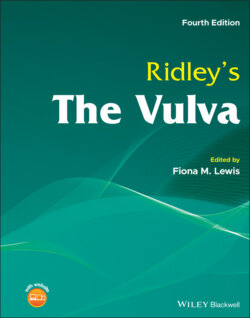Читать книгу Ridley's The Vulva - Группа авторов - Страница 61
The clitoris
ОглавлениеThe clitoris is a complex structure, and our understanding of the anatomy has been helped by the use of MRI studies [15,16].
The clitoris has a wishbone like structure with the arms being the crura extending forwards as the corpora cavernosa and meeting in the midline to form the body of the clitoris (Figure 2.4). The tip of the body then bends anteriorly to form the glans clitoris, which is the only visible part, and is non‐erectile. The glans is covered by the clitoral hood, formed by the anterior fusion of the labia minora. The crura are attached to the pubic rami and covered by the ischiocavernosus muscle, and the clitoral body is attached to the pubic symphysis by a suspensory ligament. The clitoral bulbs lie between the crura and the urethra against the vaginal wall. They are covered by the bulbospongiosus muscles, which extend from the perineal body, around the vagina and urethra, to the glans clitoris. The whole of the clitoris is composed of similar erectile tissue with the exception of the glans [16].
Figure 2.2 Variation in appearance of normal labia minora. (a) Symmetrical labia minora with pigmentation on rim. (b) Labia minora protruding outside labia majora in a patient with lichen sclerosus. (c) Fimbriation and pigmentation on rims of labia minora. (d) Asymmetry of labia minora with bifid insertion on right side.
The average clitoral width in children was measured at 3.8 mm, and this did not alter with age although the other vulval components increased with age [9]. This is important to exclude clitoral hypertrophy. In an adult study, the clitoral width was reported to increase with parity [17], but this has not been confirmed in larger studies.
